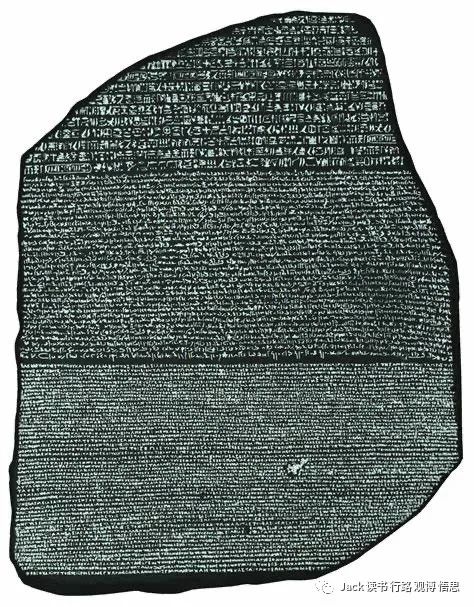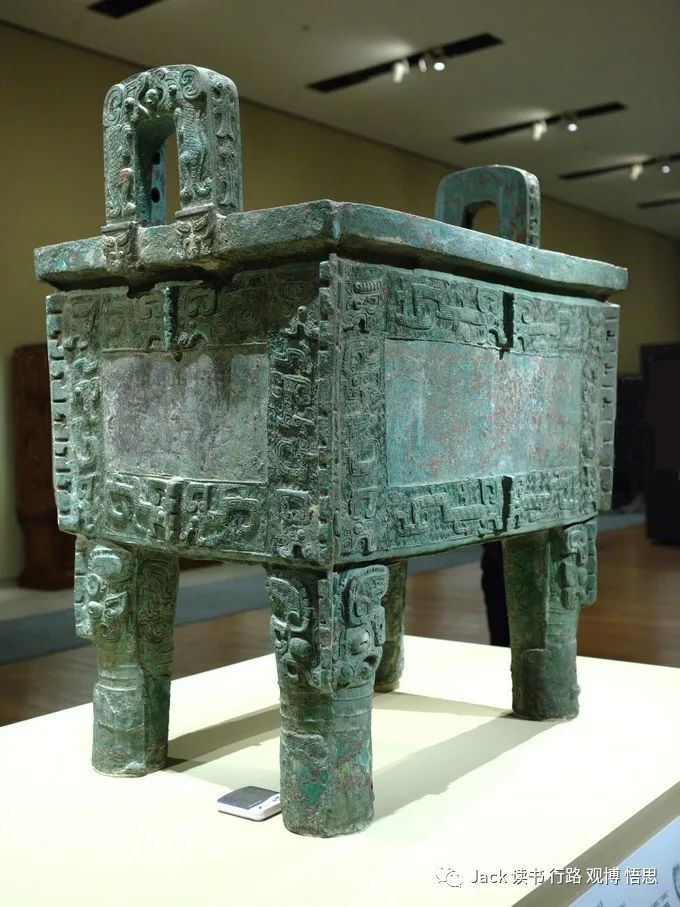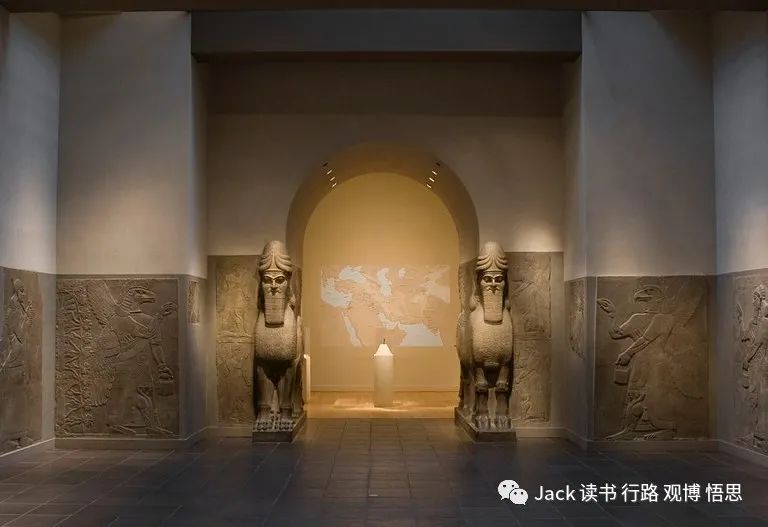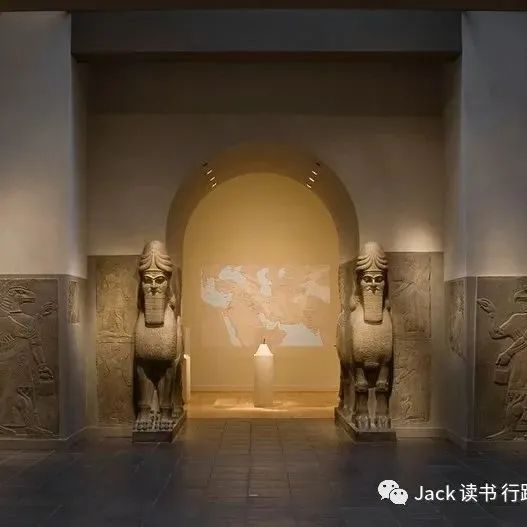Observe the Part, Recognize the Whole 1 Empires 见微知著1 - 帝国的兴衰
What is the best way to go back into history? What is the best way to see through empires' spectacular rises and falls? What is the best way to explore the flourishing and fading of cultures? Some people might claim that the best way to do so is to read history books and learn from the direction information in there; some people might claim that the best way to do so is to dig up ancient cities and ruins and use the tools of archaeology to procure a clear view of history; some people might claim that the best way to do so is to examine modern-day cultures or civilizations and attempt to find inspirations from there into the past. Yet I think the best way to do so is to immerse oneself in museums and look at small, individual artifacts or pieces of relic stored. By touching the pulse of cultures, we are face to face with the breadth of history itself; by feeling their breaths, we are on the road towards the iridescent and the magnificent Milky Way of civilizations. Through these seemingly small, fixed museum collections, the glorious and tragic fates of empires of the past unroll in front of the eyes. In this series, we will be going back into history with reference to the present moment. We will be examining the economies, politics, cultures, and many other aspects of civilizations with an objective or neutral mind. Finally, we will be analyzing the patterns and reasons of the flow of time and space itself, hoping to find inspirations for today and the future. And of course, we will be doing all these brilliant analyses and discoveries only through the small tool of individual museum collections. Welcome to the new series of this account: Observe the Part, Recognize the Whole.
The rise and fall of empires are one of the most intriguing topics to go into in history. But the rise and fall of empires do not only refer to their territorial expansions nor their dim downfall on world maps. But the phrase, more importantly, relates to the marks or memories of civilization left behind by the alterations of historical periods and the warnings or inspirations for posterity. From my point of view, by examining some of the most weighted artifacts in renowned museums across the globe, people can discover the rise and fall of once-mighty empires in a more novel, more meaningful way.

The British Museum is arguably the most incredible globally, hosting a wide range of highly weighted artifacts and collections from across the world. But one of the most precious treasures of the museum is the Rosetta Stone. The Rosetta Stone is a stone stele that documents a written decree in 196 B.C.E. of the Egyptian ruler Ptolemy V. The decree was written in three languages: Egyptian Hieroglyphics, Demotic, and ancient Greek. After being discovered in Egypt by Napoleon in 1799, the Rosetta Stone entered Europe and was finally collected by the British Museum, becoming the most vital clue to decipher the hieroglyphic writing of the ancient Egyptians. This relic from the Hellenistic Egyptian era can represent the flourishing of the Ptolemaic Empire, while at the same time, its bumpy destiny reflects the Empire's doomed fall. For the flourishing, since the Egyptians created the Rosetta Stone in three different languages, it is evidence of the cultural tolerance and diversity during that time. During the Ptolemaic Dynasty, traditional Egyptian, Greek, Persian, and cultural ideas from across the Mediterranean, Middle East, and Asia flowed in and mingled. It is the sign of the rise of a strong empire as it showcases the Empire's breadth and tolerance. But from the ultimate "burial" of the Rosetta Stone, a person can also discover the complete fall of the Egyptian Empire into Roman hands and the gradual fade of its culture as Western ones, then Islamic ones devour it. The Rosetta Stone was eventually partially destroyed, and its inscriptions' meanings were lost in history as the Ptolemaic dynasty was ended. For more than a thousand years, nobody found or deciphered the stele or its content, the memories of the entire Empire and culture obliviated. It was only until 1882 C.E. that the French linguist Champollion made progress in deciphering the hieroglyphics of the Egyptians. Today, the Rosetta Stone still sits quietly amongst the fabulous collections in the British Museum, telling the legendary story of an empire more than 2000 years ago.

On the other side of the world, the National Museum of China possesses one of the most treasured collections in the country - the Houmuwu Ding. The Houmuwu Ding, just like the Rosetta Stone, could document both the rise and fall of the Shang Dynasty and even partially allude to the reasons behind its rise and fall. The Ding is a vessel used to cook food and later turned into a ritual object, symbolizing royal power and dignity. The Houmuwu Ding is the largest Ding ever discovered, having a whopping weight of more than 830 kilograms. To produce such a magnificent and weighty vessel, a civilization must have advanced technologies in metallurgy and have the cultural deposits to give it meaning. The Houmuwu Ding has inscriptions on its surface and many traditional artistic patterns. The vessel represents the mightiest form of the Shang Dynasty, especially with its advanced technology, economy, and influence. The Houmuwu Ding is the ultimate sign of the authoritative power of the king, and at the same time, it is a vessel that radiates extravagance, power, and wealth. A person can easily imagine what hazards lie behind a prospering empire. Behind the material wealth of the Empire, there lies in the shadows an increasingly dilapidating mental state. The Shang Dynasty, towards its end, could not produce restrained, competent, far-sighted rulers and finally fell with the incompetence and corruption of King Zhou.

The American Metropolitan Museum of Art is one of the best museums in the world. One of its most precious treasures is a human-winged lion from the Neo-Assyrian Empire. The human-winged lion, or "Lamassu," is a mythical figure dating back to as early as Sumerian times. It is a symbol of strength and bravery. The "Lamassu" in the Neo-Assyrian Empire was usually put in front of the door to protect the residents. They were the guardians that "encompass all life within them." The Neo-Assyrian Empire quickly rose to power because of its military prowess and brutal system suited for times of war. The firm, courageous, and combative "Lamassu" clearly turned into the symbol for the apex of the Neo-Assyrian Empire. However, the destiny of an empire without many cultural deposits or spiritual meanings is apparent – it would face division. The Neo-Assyrian Empire had trouble containing rebellions from Babylonia within and could not fend off strong enemies outside its territory. The totalitarian and ruthless system of the Neo-Assyrians was not fit for a state to last long in peaceful times. The characteristics symbolized by "The Lamassu" helped the Assyrians achieve their prime and foreshadowed their ending.

Finally, the Egyptian Museum is home to some of the most well-known ancient Egyptian antiquities. Its most precious collection is undoubtedly the Golden Mask of Tutankhamun. Tutankhamun is a famous pharaoh from the New Kingdom Period who lived and reigned in the 14th century B.C.E. Tutankhamun, or King Tut in colloquial terms is most well-known for his mask discovered in his tomb in an intact way in 1923. This mask and his other burial objects witnessed the rise of the New Kingdom (which could be considered an empire). The New Kingdom Period was the most flourishing period in ancient Egyptian history in many aspects, be it militarily, culturally, or economically. King Tut's mask was molded and manufactured beautifully out of gold, lapis lazuli, obsidian, and other precious metals. The level of precision, the superb metallurgy and design, and the rich cultural elements (King Tut's mask shows both the religious belief and style of writing extant in ancient Egypt) displayed on the mask let a person imagine the prospering of the New Kingdom. On the other hand, the mask and its stories allude to the New Kingdom's inevitable doom. The mask, alongside more than 5000 burial objects, provides people with hints about the luxurious or extravagant lifestyle of the ruling class during the New Kingdom period. This luxury, extravagance, and material prosperity led to potential hazards that the pharaohs could not see, such as an increasingly weaker economy or centralized authority. Finally, after Tutankhamun, the line of pharaohs gradually declined in power, and their Empire collapsed within after the priests of the god Amun grew strong enough to divide the territory.
Overall, from the most precious treasures of the best museums worldwide, one can view the rise and fall of those glorious empires in a novel but intriguing way. These collections can sometimes be true microcosms of history, as they can reflect its reasons and patterns. The Rosetta Stone showcases the diversity and tolerance of the Ptolemaic Empire at the height of its power. Its subsequent stories allude to the fall of Egyptian culture and the Empire itself to the Europeans. The Houmuwu Ding is both the representation of the apex of the culture and technology of the Shang Dynasty and the sign of its final decline due to the incompetence of kings to make the right choices living a life of luxury. The "Lamassu" statues of the Neo-Assyrian Empire displays both its military prowess that pushed the Assyrians to their apex but also imply the very reason for its fall: Its militaristic totalitarian system was unfit for long-term development and prosperity in peaceful times. The Mask of Tutankhamun shows the cultural and technological prosperity during the New Kingdom Period. However, just like the Houmuwu Ding, the mask is additionally the symbol for luxury and extravagance, which brought the Egyptians down from the peak as the power of the pharaohs declined. These relics and stories prompt us to think again about the most burning yet relevant questions regarding history: How can a person connect the whole picture from tiny fragments of the past? How do we measure the success of an empire or culture? What are some of the potential hazards for an empire or culture? What common elements or fundamental values do historic empires hold that pushed them to their apex and doomed them to sink into oblivion? The answers to these questions, I believe, apply not only to the paths of empires but also to the paths of countries today and in the near future.
PICTURES CITED
https://cosmolearning.org/images/the-rosetta-stone-in-a-high-contrast-readable-format-1016/
https://courses.lumenlearning.com/boundless-worldhistory/chapter/the-shang-dynasty/
https://theculturetrip.com/north-america/usa/new-york/new-york-city/articles/10-must-see-artworks-at-nycs-metropolitan-museum-of-art/
https://www.npr.org/templates/story/story.php?storyId=123781211
什么是回到历史的最佳方式?什么是透视帝国兴衰的最佳方式?什么是探索文化与民族的繁荣和消亡的最佳方式?有些人可能会说,最佳的方式是阅读历史书,从其中的信息寻找探寻的方向;有些人可能会说,最佳的方式是挖掘古城和废墟,利用考古学的工具来获得清晰的历史观;还有些人会说,最佳的方式是研究现代文化和文明,并试图从这里找到来自于过去的启示。然而,我认为最佳的方式之一是把自己置身于博物馆,去面对那些真实的单个的文物或遗物。通过触摸这些文物的脉搏,我们就有能力面朝历史本身的广度;通过感受这些文物的呼吸,我们就有能力踏上通往斑斓壮丽的文明星河的道路;通过观察这些看似微小、凝固的博物馆藏品,帝国曾经的辉煌和最终的覆灭就会在眼前展开。在这个系列中,我们将置身在现代文明中去回顾历史。我们将以客观、中性的心态审视曾经的帝国与文明的经济、政治、文化等许多方面。我们将试图透彻剖开时间、空间流动本身的规律和原因,为今天和未来找到灵感。欢迎来到这个新系列:见微知著,睹始知终。
帝国的兴衰是历史学科中最引人入胜的话题之一。"帝国的兴衰 "绝不仅仅是那些大帝国曾经在世界版图中的盛极一时,也不是它的黯然衰落,而是在这兴衰交替中所留下的那些文明印记,那些警醒后世的精神启迪。从我的观点来看,通过研究全球知名博物馆中一些最具分量的重要文物,我们可以用一种更新颖、更有意义的方式来发现那些曾经的伟大帝国,以及它们的兴衰。

大英博物馆可以说是世界上最伟大的博物馆,拥有来自世界各地最具重量级的文物和收藏,其可以用“浩瀚”来形容。该博物馆最珍贵的宝藏之一是罗塞塔石碑。罗塞塔石碑是一块拥有极高历史研究价值的石碑,记录了公元前196年埃及统治者托勒密五世的一项书面法令。石碑上有三种文字:埃及象形文字、埃及通俗语和古希腊语。罗塞塔石碑于1799年被拿破仑发现,之后便被带入欧洲,最终被大英博物馆收藏,成为破解埃及象形文字最关键的线索。这个希腊化埃及时代的遗物既能代表埃及托勒密王朝的繁荣,后期颠沛的命运也谱写了王朝最终的衰落。就繁荣而言,由于罗塞塔石碑是用三种不同的语言创作的,它是那个时代文化宽容和多样性的证据。在托勒密王朝时期,传统的埃及、希腊、波斯以及来自地中海、中东和亚洲各地的文化思想流入并相互交融在一起。文化交融与多元性是一个帝国强大的标志,它展示着帝国的胸襟和气度。但从罗塞塔石碑最终被掩埋,人们也可以理解托勒密王朝的帝国最终完全落入罗马人之手,其埃及传统文化被希腊罗马文化及后期的伊斯兰文化逐渐吞噬,最终消亡。罗塞塔石碑最终被部分摧毁,其文字的含义也随着托勒密王朝的终结而消失在历史中。一千多年来,没有人发现或破译这块石碑或其内容,整个帝国的文化记忆被遗忘,直到1882年,语言学家商博良才完成埃及象形文字破解的突破性进展。 罗塞塔石碑这块灰黑色花岗岩打造的纯文字碑现在依然矗立在大英博物馆灿若星河的藏品中,静静的诉说着那个二千年前帝国的传奇故事。

在世界的另一端,中国国家博物馆拥有该国最珍贵的收藏之一------后母戊鼎。后母戊鼎,就像罗塞塔石碑一样,记载着商朝的兴衰,甚至部分地暗示了商朝兴衰的原因。鼎是一种用于烹饪食物的器皿,后来成为一种礼器,是王权和尊严的象征。后母戊鼎是迄今为止发现的最大的鼎,其重量高达830多公斤。要制造这样一个宏伟而厚重的器物,一个文明必须拥有先进的冶金技术,并有文化积淀来赋予其意义。后母戊鼎的表面有铭文,并有多种传统艺术图案。该器物代表了商朝最强大的状态,代表了商朝先进的技术、经济和文化影响力。后母戊鼎是国王权威和权力的最终标志,同时它也是一个散发着王朝富足、奢侈之气的器物。人们很容易想象, 在一个富裕帝国的背后究竟潜藏着怎样的危机?繁荣富裕的帝国在丰裕的物质享受背后,潜藏的却是精神状态的日趋崩坏,这个王朝再也没能产出节制、精明、具备远见的统治者,最终在商纣王的无能和腐败中走向衰亡。

美国大都会艺术博物馆是世界上最好的博物馆之一。它最珍贵的藏品之一是新亚述帝国的人翼狮“拉玛苏”。拉玛苏是一个可以追溯到早在苏美尔时代的神话人物,是力量和勇敢的象征。在新亚述帝国,拉玛苏通常被安放在门前以保护住者,是 "将所有生命都囊括其中 "的大守护者。新亚述帝国因其强悍的军事能力和适合战时的冷酷、残暴的系统制度而迅速崛起。雄壮、勇猛、好战的守护者 "拉玛苏 "俨然就是新亚述帝国巅峰的象征。一个缺乏文化积淀和精神内涵的帝国,其最终的命运显而易见——分裂。新亚述帝国对内难以遏制来自巴比伦的叛乱,对外无法有效抵御其领土之外的强敌。新亚述人的极权主义和无情、残暴的制度不适合一个国家在和平时期长期治理。"拉马苏 "所象征的特质既成就了威震一方的强大帝国,也为帝国最终的崩溃埋下了伏笔。

埃及开罗博物馆是古埃及文物的馆藏之地,是所有历史迷最向往的地方,其最珍贵的藏品无疑是图坦卡蒙黄金面具。图坦卡蒙是新王国时期的法老,他的统治时期在公元前14世纪。图坦卡蒙最闻名的是1923年他的墓葬的惊世发现。图坦卡蒙黄金面具及其他丰富奢华的墓穴陪葬品见证了埃及新王国(新王国可以算是一个帝国)的兴盛。新王国时期在诸多方面都是古埃及历史上最繁荣的时期,无论是在军事上、文化上还是经济上。图坦卡蒙的面具是用黄金、青金石、黑曜石和其他贵重金属塑造和制造的,非常精美。面具上显示的制造精确程度、精湛的冶金锻造技艺以及丰富的文化元素设计(图坦卡蒙的面具显示了古埃及当时的宗教信仰和文字风格)等均可以让人想象到新王国的繁荣景象。然而,另一方面,面具和它的故事也暗示了新王国不可避免的厄运。面具及保存完好的超过5000件的陪葬品完整地向世人展现了法老及贵族豪华、奢靡的生活方式。这种豪华、奢靡的生活方式注定让统治者无法看见帝国潜在危险,如经济或中央集权的日益衰退。在图坦卡蒙之后,法老一系的权力逐渐下降。最终,在阿蒙神的祭司们强大到足以瓜分领土之后,他们的帝国从内部也就瓦解了。
总的来说,从全世界最好的博物馆的最珍贵的宝藏中,人们可以以一种新颖但耐人寻味的方式来看待那些辉煌帝国的崛起和衰落。这些藏品有时可以成为历史的真正缩影,因为它们可以反映出历史发展的原因和规律。罗塞塔石碑展示了托勒密帝国在其鼎盛时期的文化多样性、宽容性,但同时石碑的后续故事也影射了埃及文化和帝国本身在欧洲人入侵之后的衰落。后母戊鼎既是商朝文化和技术顶点的代表,也是商朝最后因为毫无戒慎恐惧、奢华无度而衰落的标志。新亚述帝国的 "拉玛苏 "雕像既展示了其将亚述人推向巅峰的军事能力,也暗含了其衰落的根本原因,其军国主义的极权制度不适合在和平时期长期发展和繁荣。图坦卡蒙的面具显示了新王国时期文化和技术的繁荣。然而,就像后母戊鼎一样,面具也是奢华和奢侈的象征,它使埃及法老一系从其权力的顶峰跌落。这些文物及其背后的故事促使我们再次思考一些在历史方面最迫切但又最相关的问题。一个人如何能从过去的小碎片中把整个事件的线索联系起来?我们如何衡量一个帝国或文化的成功?一个帝国或文化潜在的危机有哪些?历史上的帝国拥有哪些共同的元素或关键的价值使它们被推到顶峰,又注定要沉沦或被遗忘?我相信,这些问题的答案不仅适用于古代帝国的道路,更适用于今天和未来的现代国家的道路。
- 本文标签: 原创
- 本文链接: http://www.jack-utopia.cn//article/425
- 版权声明: 本文由Jack原创发布,转载请遵循《署名-非商业性使用-相同方式共享 4.0 国际 (CC BY-NC-SA 4.0)》许可协议授权










